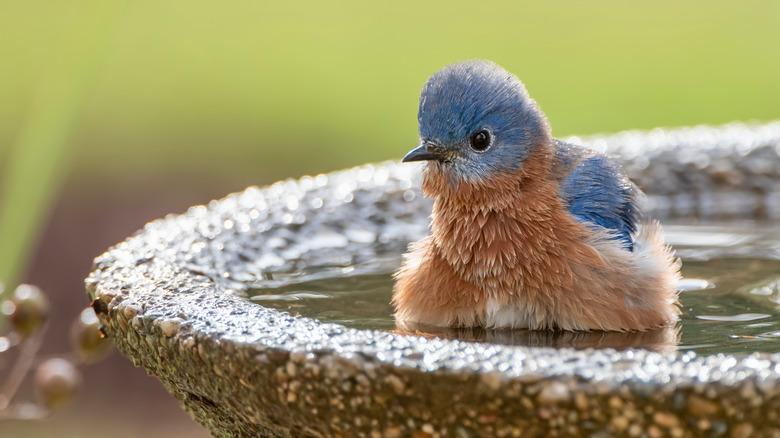Why Do People Put Pennies In Their Birdbath And Do You Need To?
Installing a birdbath is a key step in creating a bird-friendly garden. Birds drink from their birdbath as well as bathe in it, so keeping it clean is just as important as installing it in the first place. Algae can easily grow in a birdbath, especially in the heat of the summer or when placed in direct sunlight. How (and how often) one should clean a birdbath is a common question, and tossing a few copper pennies into the birdbath is an answer found frequently online. Copper has long been used to control algae. The most commonly used form is water-soluble copper sulfate, which contains ionized copper, since it's the copper ions released into the water that kill the algae.
If you want to test to see if a few pennies work, try an experiment in your home before trying it out on birds, who are already facing enormous environmental challenges. Remove some algae-containing water from your bird bath and place it in a bowl. Bring the bowl indoors and set it in a sunny place. Sterilize your pennies in boiling water or bleach so that lotions, skin oils, bacteria, and other organic material don't taint your experiment, then place the pennies in your bowl. After a day or two, see if the algae has died or has at least stopped growing. But does this work, and is it safe?
Simple alternatives to keeping your birdbath clean
You might be disappointed. It's likely that a few pennies will not do much good in controlling algae. Pennies in circulation since 1982 are only a 2.5% copper coating, while the inner core is zinc. You would also probably need to ionize the copper coating for it to have much effect on algae. And of course, pennies aren't water-soluble. Fortunately, there are simpler ways to keep your birdbath algae-free.
Putting your birdbath in the right place is a good place to start: A shaded, well-covered area helps reduce algae growth and discourages mosquitoes from laying eggs. Kenn and Kimberly Kaufman, authors of the well-regarded Kaufman Field Guide books, noted to Birds & Blooms that it's moving water that prevents algae growth, so adding a fountain can help keep algae from growing. But so can a hose and a brush. The Audubon Society recommends regularly rinsing and scrubbing your birdbath with nine parts water to one part vinegar. The Kaufmans recommend cleaning and changing the water every few days, though in the high heat of summer, they scrub their feeders and change the water every day. Repainting your bird bath from time to time can also help remove areas where organic material can accumulate.
If you are still thinking about adding a few pennies to your birdbath, it would be wise to consult a wildlife specialist first. According to the Currumbin Valley Bird, Repite & Exotic Veterinary Services, copper is considered toxic for birds, which can cause gastrointestinal issues or possibly even death. Seeing if your pennies control algae is at least a good experiment to teach young people science, but reconsider trying it out in a bird bath. You might still have some luck by just tossing your pennies into a fountain far away from birds.

